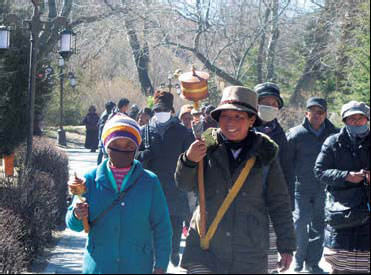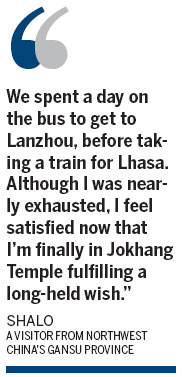Lhasa crowded with pilgrims
|
Chonggyi (right), a 51-year-old farmer in Yabda village near Lhasa, has come to Lhasa almost every day to pray in temples since December. In the morning, she and fellow villagers travel by bus to the city, and they return home in the afternoon. [Dachiog / China Daily] |
|
|
LHASA - The peak season has come for prayer, and Buddhists from ethnic Tibetan regions have been flocking to Lhasa since the start of winter, when they have the most free time from farming and animal husbandry.
On Tuesday, pilgrims crowded the square leading to Jokhang Temple, a popular destination for Tibetans in Lhasa, capital of Southwest China's Tibet autonomous region, to offer prayers. A long line moved slowly toward the entrance of the temple as white smoke from incense wafted through the doorway. The sound of people praying and vendors shouting filled the air.
"The number of visitors to Jokhang Temple has been increasing recently. The temple had about 8,000 visitors today," said Lhagba, a monk and director of the management committee of the temple.
Aside from Jokhang Temple, visitors also crowded some other religious sites, such as Ramoche Temple and Potala Palace, while traffic police were busy keeping order at road crossings.
Lhasa receives nearly a million Buddhists from the Tibet autonomous region and other areas with Tibetan populations, such as Sichuan, Gansu and Qinghai provinces, each winter, when farmers have the most free time, official statistics shows.
"I've come to Lhasa to pray almost every day since December with four others from my village," said Chonggyi, 51, a farmer in Yabda village near Lhasa. She arrives in the morning by bus, prays at temples, such as Jokhang Temple and Potala Palace, and returns home in the afternoon.
"I don't have to worry about food or shelter as our life becomes better and better, so I offer prayers with my friends, and it feels good," she said.
For Shalo and 14 relatives and friends, who come from Gansu province, a chance to visit Lhasa and pray in Jokhang Temple is worth the arduous journey.
"We spent a day on the bus to get to Lanzhou, before taking a train for Lhasa. Although I was nearly exhausted, I feel satisfied now that I'm finally in Jokhang Temple fulfilling a long-held wish," he said.
Tsogyldorje arrived in Lhasa from Burang county with his family and prayed to the Sakyamuni Buddha in the Jokhang Temple after waiting for three hours in line. After praying, he could not find his 8-year-old son, Ngwangtsepel.
"I noticed a police station near the square outside the temple, so I asked them for help," he said.
Although police officers found the child within an hour, they're straining under the burden of dealing with so many visitors.
"Since the beginning of the winter the number of pilgrims has increased rapidly, and that has kept us very busy. We have to be on duty 24 hours a day to keep order and provide hot water, medicine, wheelchairs and fire extinguishers for prayers and visitors," said Zhu Jie, a police officer who helped search for the boy.
The sharp increase in the number of visitors has also put stress on the hotels and housing rentals. Statistics on Tuesday show there were 780 visitors in a community near Barkhor, a street near Jokhang Temple, while the number of the community's permanent residents was only 995.
China Daily




















